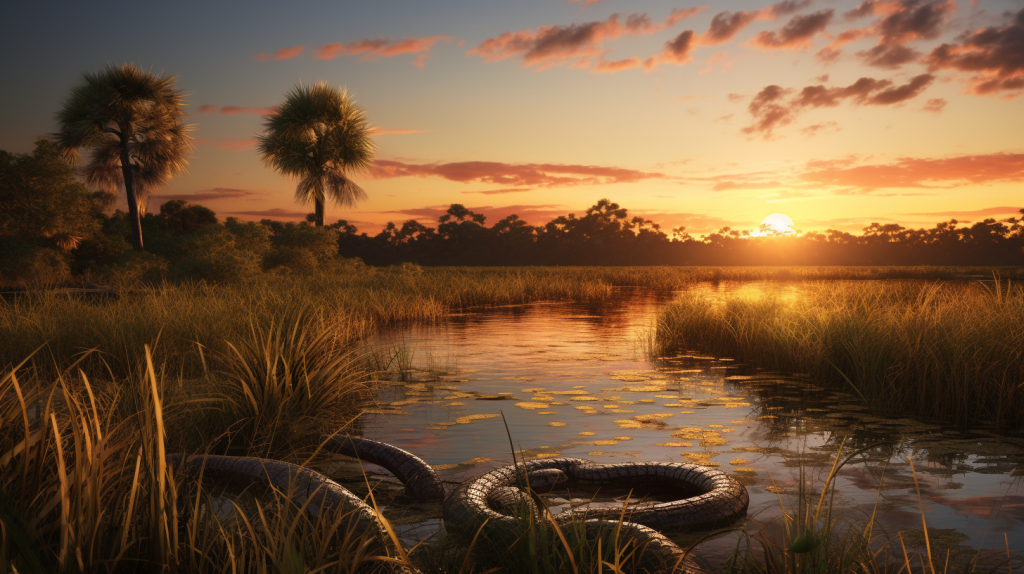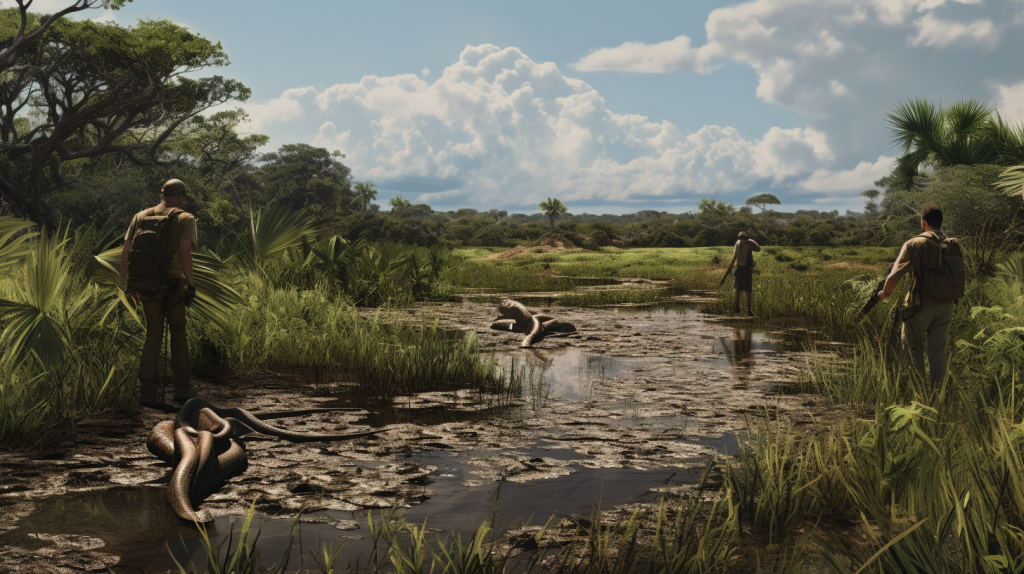Ever wandered through Florida’s iconic wetlands and wondered, “Did that vine just move?” Well, you might not be as far off as you think, the python in Florida everglades reign. The Florida Everglades, a unique tapestry of ecosystems, is currently grappling with an unexpected invader: the Burmese python. From altering delicate food chains to pushing certain species to the brink, these snakes have made quite the splash in this pristine wilderness.
The Uninvited Guests: How Did Pythons Get Here?
These massive constrictor snakes, not indigenous to the region, have raised a curious question: how exactly did they find their way to the Everglades? Theories abound, offering a glimpse into the enigmatic origins of this invasive species. One popular hypothesis suggests that the chaos wrought by Hurricane Andrew in the 1990s played a pivotal role.
It is speculated that a python breeding facility was obliterated by the storm, inadvertently setting free these formidable serpents into the wild. Another perspective points to overwhelmed pet owners as potential culprits, who, facing the challenge of caring for these giant reptiles, might have decided to release them into the Florida landscape.
Regardless of the specific chain of events, one chilling consequence became evident: bereft of natural predators in their newfound habitat, the python population experienced an exponential surge. As a result, the ecosystem of the Everglades faced disruption, sparking concerns about the delicate balance of the environment and the urgent need to address the invasion of these uninvited guests.
Apex Predators in a Fragile Ecosystem
The concept of apex predators within a delicate and interconnected ecosystem takes on a unique dimension when considering the example of pythons in Florida. While in their native habitat of Southeast Asia, pythons coexist with natural checks and balances that help regulate their population and maintain ecological equilibrium, the story takes a starkly different turn in the Florida Everglades.
In this new environment, these formidable reptiles have elevated themselves to the top of the local food chain, with a voracious appetite that knows no bounds. The consequences of their unchecked predation ripple throughout the delicate fabric of the ecosystem. Avian species that once enjoyed relative safety now find themselves potential targets for these invaders, as pythons demonstrate an astonishing ability to consume birds along with mammals and even alligators.
The shift in the predator-prey dynamics underscores the fragility of ecosystems when confronted with the introduction of apex predators that lack natural predators of their own. As conservationists grapple with the challenge of mitigating the impact of these non-native pythons, they are faced with the daunting task of restoring a balance that can safeguard the intricate relationships that define a thriving and harmonious ecosystem.
Ecosystem Imbalance: The Ripple Effect
Ecosystems are intricate webs of life where every species plays a crucial role in maintaining balance. The invasion of pythons in the Everglades has brought about a disruptive ripple effect that is altering the delicate equilibrium of this unique habitat. As these insatiable predators indulge in their relentless feasting, a cascade of consequences reverberates through the environment.
Species such as marsh rabbits and raccoons, which once thrived in abundance, are now becoming increasingly rare sights. The python’s voracious appetite for these mid-sized mammals has led to a drastic reduction in their populations, leading to a vacuum in the ecological niche they once occupied. This, in turn, triggers a secondary upheaval: the unchecked growth of the plants that were once kept in check by these herbivores.
With fewer herbivores to graze upon them, plants experience unhindered expansion, altering the landscape and potentially depriving other species of essential resources. The phenomenon serves as a stark reminder of the interconnectedness of all life forms within an ecosystem and the profound impact that the presence or absence of a single species can have on the intricate dance of nature.
As scientists and conservationists grapple with finding solutions to restore balance, they face the challenge of not only managing the python population but also addressing the far-reaching repercussions of their predatory behavior.
Controlling the Python Population: A Herculean Task
Addressing the burgeoning python population in the Everglades has proven to be a herculean task that requires innovative approaches and dedicated efforts. These elusive creatures, masters of camouflage, effortlessly blend into the dense undergrowth of their new habitat, making their detection and control an intricate challenge.
Nevertheless, humans are rising to the occasion, determined to counter this threat to the delicate ecosystem. The fight against the python invasion has taken on a multifaceted approach, incorporating various strategies to mitigate their impact. One such method involves organizing python hunts, where skilled hunters scour the landscape in pursuit of these slithery invaders.
These hunts not only aid in reducing python numbers but also raise awareness about the issue among the public and engage local communities in the conservation effort. Additionally, the deployment of specially trained detection dogs has proven invaluable in locating pythons hidden within the intricate vegetation.
These highly skilled canines use their acute sense of smell to pinpoint the presence of these elusive predators, assisting researchers and authorities in their quest to curb the python population. As humans adapt and innovate to confront this ecological challenge, the fight against the invasive pythons showcases the determination and ingenuity required to restore balance to a fragile ecosystem under threat.
Python vs. Alligator: Clash of the Titans
There are dramatic tales and even photos of pythons battling the Everglades’ original apex predator, the alligator. The stories that unfold within this unique ecosystem are nothing short of dramatic, with tales of epic battles between these formidable creatures captivating the imagination. Remarkable photographs have captured moments of intense struggle as pythons and alligators engage in a primal contest for supremacy.
While alligators boast a formidable set of jaws and an impressive armored exterior, pythons bring their own strengths to the confrontation, including their powerful constriction abilities and stealthy maneuvers. Despite the alligator’s reputation as the original apex predator of the Everglades, the invasive pythons often emerge victorious in these encounters. These battles underscore the adaptability and resilience of the python species in their new habitat.
In some instances, pythons have even managed to consume their reptilian rivals, a testament to their insatiable appetite and adaptability. As these apex predators vie for dominance in this dynamic ecosystem, the clash between python and alligator becomes a poignant illustration of the intricate interplay between species and the ever-evolving struggle for survival in the natural world.
Ecotourism and the Python Problem
The allure of the Everglades as a natural wonder draws ecotourists from around the world, eager to experience the diverse array of wildlife that inhabits this unique ecosystem. However, the growing python problem has introduced a complex dilemma for both visitors and the delicate balance of the environment.
For some tourists, the prospect of encountering a python in the wild can be a thrilling and exotic experience, adding an unexpected layer of excitement to their journey. Yet, the python invasion carries an unintended consequence: a decline in encounters with native animals that once defined the Everglades’ allure.
As these invasive snakes disrupt the natural predator-prey dynamics, native species like birds, mammals, and reptiles become less visible and harder to spot during ecotourism expeditions. This shift in wildlife dynamics can lead to disappointment among tourists who hope to witness the diverse range of species that the Everglades is renowned for.
The challenge now lies in finding a way to manage the python population while maintaining the delicate balance of the ecosystem, ensuring that ecotourism can continue to thrive and provide a window into the natural wonders of this unique environment without compromising the experiences of visitors seeking encounters with native wildlife.
Educate, Act, Preserve
In the ongoing battle to address the python invasion in the Everglades, a multifaceted approach centered on the pillars of education, action, and preservation has emerged as a crucial strategy. Education stands as a foundational element in this effort, playing a pivotal role in preventing the further spread of the problem.
By raising awareness about the significant impact that these invasive pythons have on the delicate ecosystem, there is a chance to discourage the release of these snakes into the wild by pet owners who might not fully understand the consequences of their actions. By highlighting the potential ecological disruptions caused by the python invasion, education empowers individuals to make informed decisions that can safeguard the environment.
However, education alone is not enough. Action is paramount in tackling the python issue head-on. With more eyes on the ground, there is an increased likelihood of spotting and removing these invasive snakes.
This calls for collaboration among scientists, conservationists, local communities, and concerned citizens. Initiatives such as python hunts and training programs for detection dogs exemplify the proactive steps being taken to mitigate the python population’s growth. These actions demonstrate the dedication of those invested in preserving the Everglades’ ecosystem, creating a direct impact by reducing the numbers of these invasive predators.
A Glimmer of Hope: Adapting to Change
Amidst the challenges posed by the python invasion in the Everglades, a glimmer of hope emerges through the remarkable resilience of nature itself. In response to the disruptive presence of these invasive predators, the ecosystem is displaying its ability to adapt and evolve.
One striking example of this adaptation can be observed in the behavior of certain bird species. In an effort to evade the threat posed by prowling pythons, some birds are making a subtle yet significant shift in their nesting habits.
These avian inhabitants are now choosing to nest at higher elevations, a behavior that provides a tactical advantage against the ground-dwelling pythons. This remarkable adjustment is a testament to the innate ability of species to respond to environmental changes and challenges, showcasing the intricate mechanisms by which nature maintains its equilibrium.
Conclusion: Python In Florida Everglades
The invasion of the python in Florida everglades underscores how human actions, whether intentional or accidental, shape our environment. By learning from the Everglades, we can better understand our profound impact on nature and take steps to safeguard other ecosystems.
FAQs
Q: How big can Burmese pythons get?
Some specimens in the Everglades have reached lengths of over 18 feet!
Q: Are there any predators for pythons in Florida?
Besides larger alligators on occasion, adult Burmese pythons in Florida have few natural predators.
Q: How many pythons are in the Everglades?
Exact numbers are hard to pin down, but estimates range from tens of thousands to hundreds of thousands.
Q: Do pythons pose a danger to humans?
While Burmese pythons are not typically aggressive towards humans, they can pose a threat if they feel threatened or cornered.
Q: What’s being done to curb the python population?
Besides organized hunts, researchers are exploring genetic and biological control methods.
References





